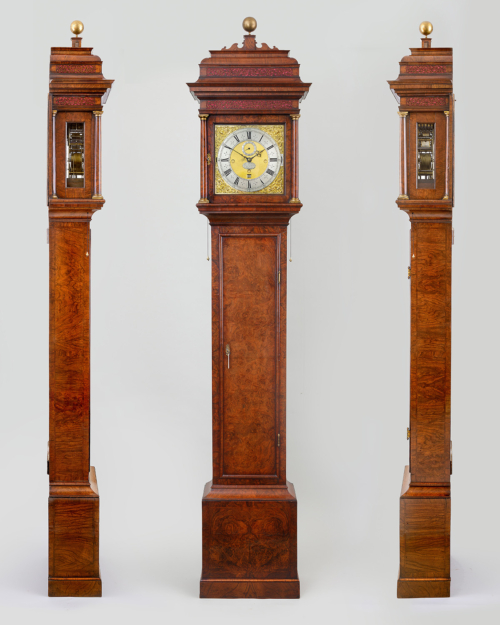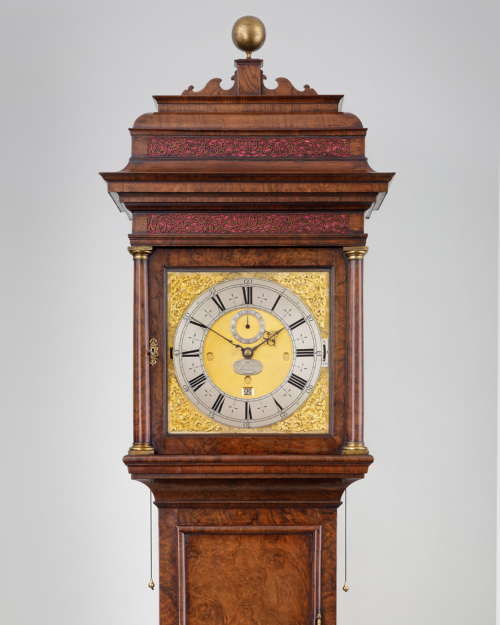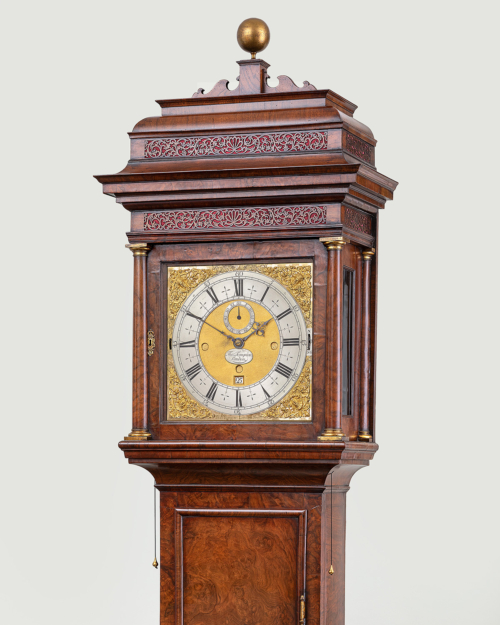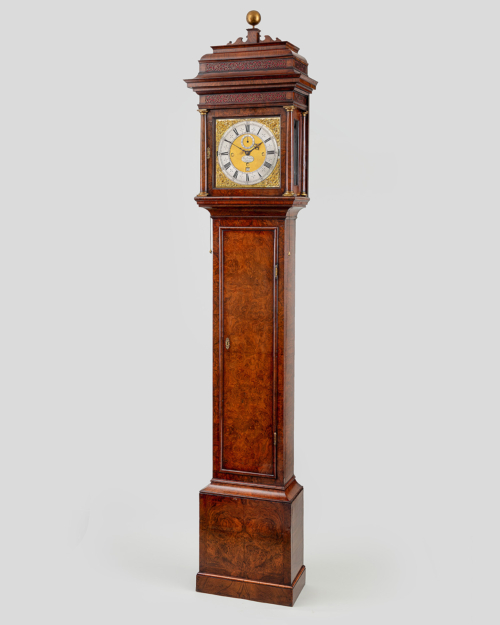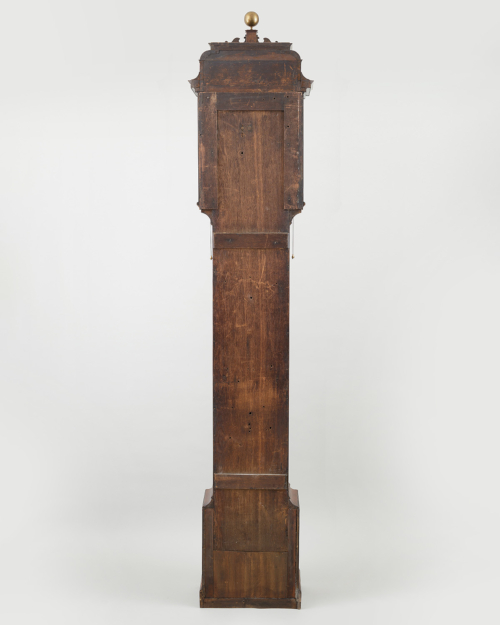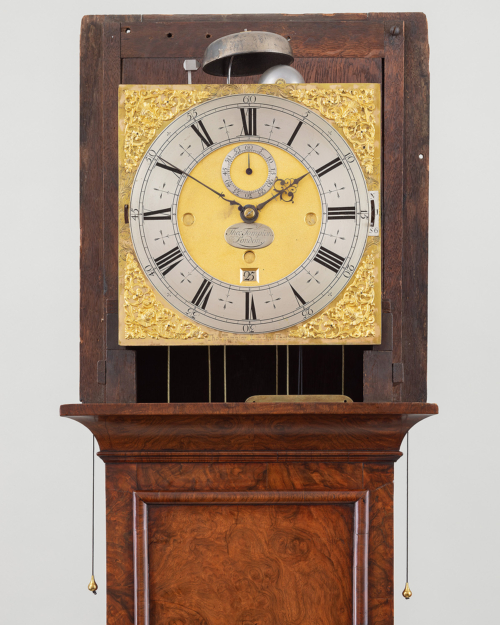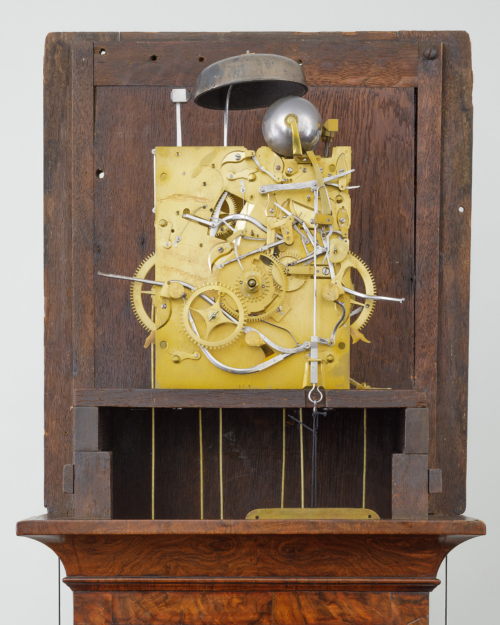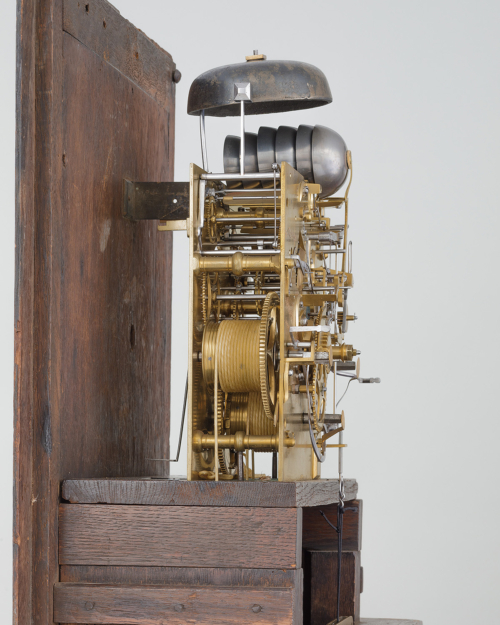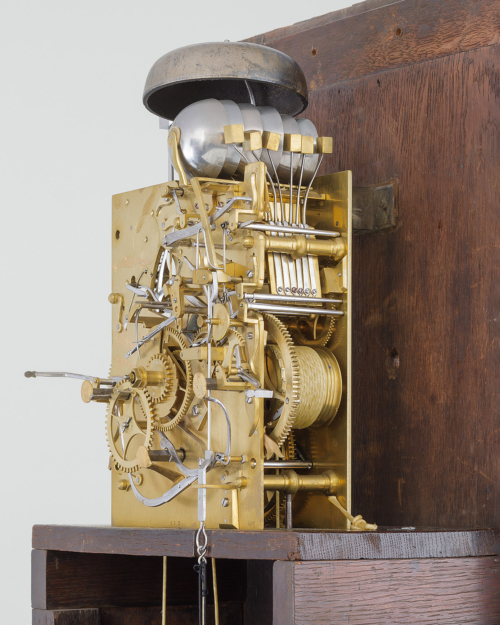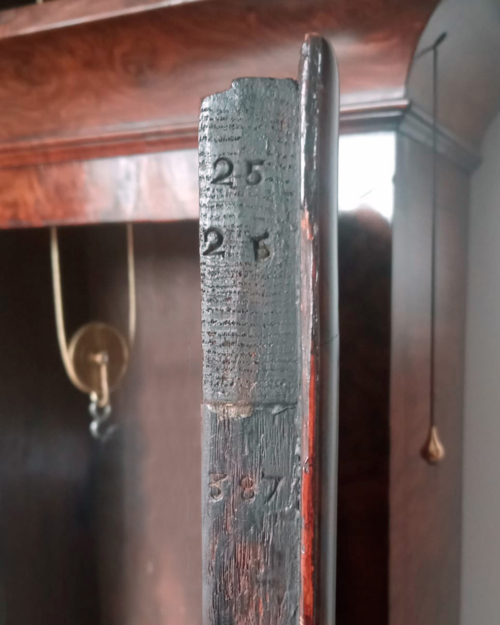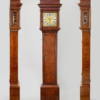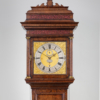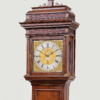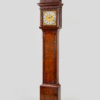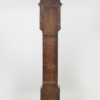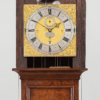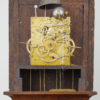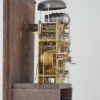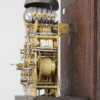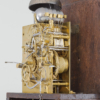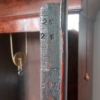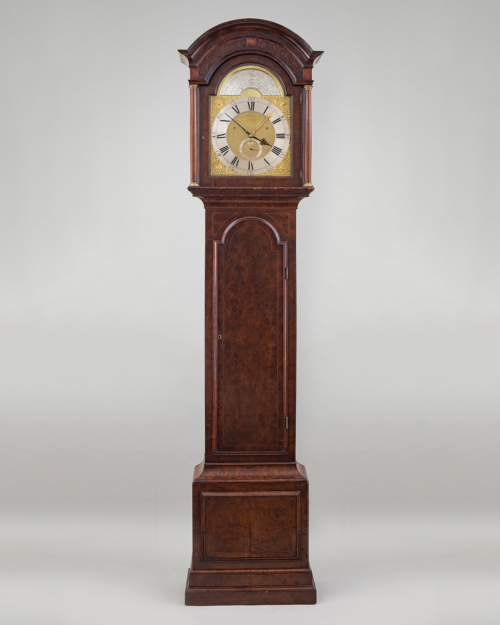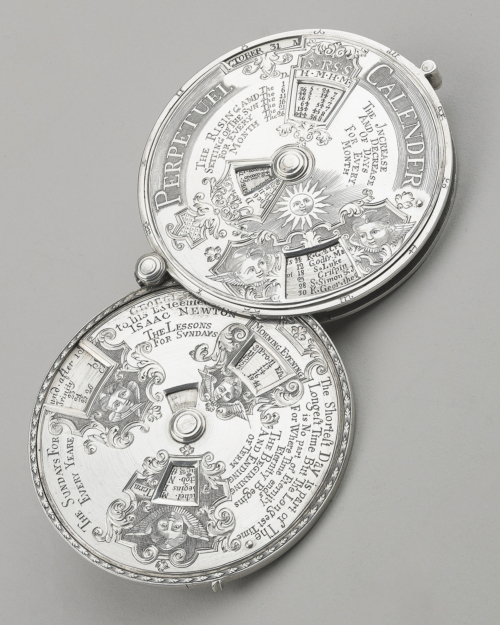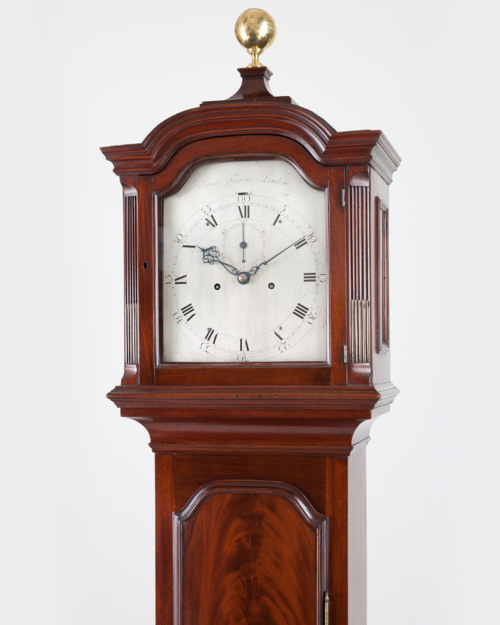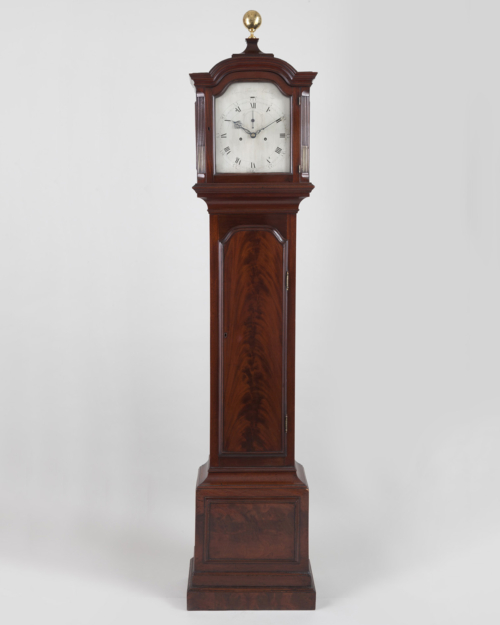| Height | 8 foot 3½ inches (2527 mm) |
| Case | The ‘special’ commissioned Type 3 case (see notes following, and p.166‑8), veneered in burr walnut onto an oak carcass, of Tompion’s fully-developed Type 3 form with hood door, dial mask and forward sliding hood. The hood top restored above the dome, centred by a brass ball finial with pedestal flanked by shaped upstands, the original top freize above the cornice with an archetypal extra ‘step’ below, unique to Tompion’s ‘special’ Type 3 longcases, with pierced walnut sound frets to the front and sides. The lower frieze supported by typical brass-capped Doric columns flanking the hood door and with matching quarter-columns to the hood fillets at the rear. The hood supported by concave throat mouldings with internal roller-guides for the repeat cords, above the burr-walnut veneered rectangular trunk door with half-round frame mouldings, stamp-numbered 387, 25 and 26 on the upper leading edge, the concave base moulding above the partially restored, cross-banded and herringbone inlaid burr-veneered plinth, and raised on a later single walnut skirting. The backboard with original dust-excluding chamfered extensions, only apparently found on Tompion’s complicated ‘special’ clocks, to seal behind the hood. |
| Dial | The 11½ inch (290 mm) gilt-brass dial with silvered chapter ring typically engraved with Roman hours, sword-hilt half-hour marks and Arabic minutes with cross half-quarters outside the division ring. The blued steel hands finely pierced and shaped. The finely matted centre signed on a reserve Tho. Tompion Edw. Banger London, and subsequently but typically overlaid with an oval silvered plaque signed Tho: Tompion London, also with seconds ring, pin-hole calendar aperture and three shuttered winding holes, the maintaining-power lever slot to the edge of dial outside IX. The strike control lever outside III with an upgraded silvered plaque engraved N (no strike), 1 (for one bell quarter-strike) and S6 (for six bell quarter-strike). There is also strike-selection engraved on the dial plate, beneath the current plaque. The double-screwed gilt-brass Indian mask & scroll corner spandrels, with decoration between by Graver 195, except for the bottom edge that is further signed Tho: Tompion Londini Fecit. The whole dial attached to the movement by four latched dial feet. There is a differing, previous strike-selection notation engraved on the dial plate, beneath the added current plate |
| Movement | The highly complex and substantial full Grande Sonnerie movement with six latched baluster pillars; the going train with anchor escapement and bolt-and-shutter maintaining power, via the dial lever at IX; both the hour and quarter strike trains rack and snail governed, the hours striking on the large bell and the quarters on six graduated bells, with an option to reduce to a single bell via the silent/strike option lever through the dial at III, and repeating via a frontplate mounted, cock-guided, vertical pull-lever down to below the seatboard to attach, via trunk-mounted roller-guides, to the exit cords. Typically for all Tompion’s grande sonnierie movements by this time, punch-numbered 387 at the bottom centre of the backplate and further similarly numbered 387 at the bottom centre of the frontplate. The brass-rod pendulum with lenticular bob and calibrated rating nut, with three brass cased weights. The movement fixed in the usual manner with seatboard screws into the base pillars and a bracket to the backboard. |
| Duration | 8 Days |
| Provenance | Possibly ordered by George of Denmark on Queen Anne’s accession; |
| Literature | Antiquarian Horology, Autumn 1989, Winterton, ‘English Grande Sonnerie Clocks’, p.307; |
| Escapement | Anchor with one second pendulum |
| Strike Type | Three-train full Grande Sonnerie with trip repeat |
| Exhibited | 1997, Grosvenor House Antiques Fair, with Asprey; |
Exhibit № 36. The Pearson Tompion No.387, Circa 1703
A highly important Queen Anne ‘special’ Type 3 burr walnut three-train full Grande Sonnerie striking and trip-repeating longcase clock, by Thomas Tompion & Edward Banger, London
£795,000
This highly important clock is the last of Tompion’s three extant numbered full Grande Sonnerie longcase clocks; the others being The Royal Exchange longcase, no.131, of probable royal provenance; and longcase no.275, which is still in the Royal Collection (RCIN 30102), but now missing its quarter train, which was removed in the 19th century by the royal clockmaker, Benjamin Lewis Vulliamy.
Tompion’s three-train series of Grande Sonnerie clocks were a sequential development from his spring driven two-train Grande Sonnerie movements (such as the Sussex Tompion in this collection, inventory no.27). The striking trains of all Tompion’s Grande Sonnerie clocks do not require any manual power to be induced by pulling the repeat cord and therefore are best described as ‘trip’ repeating. Interestingly, and possibly because Tompion always intended to produce them in batches, the three-train full Grande Sonnerie series are the only ‘special’ clocks that Tompion chose to number in his usual manner (although with a repeated number to the frontplate), the series includes both spring and weight driven clocks and was aimed at his most influential clientele.
In keeping with the majority of the series’ royal provenance, the dating of no.387, c.1703, suggests a royal commission from Prince George of Denmark on the ascension of his wife, Queen Anne. In The Golden Age of English Horology, 2015, Garnier argues that George of Denmark was certainly as enthusiastic a customer of Tompion’s as William III had been before him and, arguably, even more ambitious with his commissions. The previous Grande Sonnerie longcase no.275 had been commissioned by William III and was probably delivered in c.1698/9. Garnier argues that a pattern emerged with George’s commissions: How sweet it must then have been for George to have so surpassed his late brother-in-law’s… in the clocks he himself commissioned from the same maker once he, newly as consort to the succeeding monarch, was freed from the financial constraints William had kept him under and so could indulge himself.
It might be significant that the consecutively numbered clock to this example is The von Plessen Tompion no.388, which is a standard Phase 2 spring clock but bearing that family’s arms (Royal Collection, RCIN 30362, entering the collection in 1935). Tompion no.388 was made for Christian Siegfried von Plessen (1646‑1723) who was a particularly close confidant and friend of Prince George of Denmark, becoming his Lord Chamberlain in 1678 and accompanying him to London in 1683 for his marriage to Anne Stuart. He later returned to serve as the new Danish envoy and afterwards continued to make regular diplomatic visits to London. The use of arms in Tompion’s oeuvre was most usually connected to diplomatic gifts (such as the Medici, de Conde and Habsburg Tompions, all from this series), which might hint at a royal gift from George to his native Danish confidant, while the consecutive numbering of these two clocks suggests they might have been ordered together in c.1703. Despite rising in government in Denmark, von Plessen remained in service to George, as his Keeper of the Privy Purse, from 1684 until the prince died on 28th October 1708 at Kensington Palace, London.
The known and putative provenances of the whole three train Grande Sonnerie series read like a Who’s Who of contemporary English and European sovereign princes, as well as leading, influential courtiers:
The Royal Exchange Tompion, no.131, c.1688. Walnut Type 2 longcase. Tompion’s first full Grande Sonnerie clock, arguably ordered by William III, on deposing James II.
No.133, c.1688. Ebony Phase 1 table clock, possibly ordered at the same time as no.131 by William III.
No.169, c.1690. Ebony Phase 1 table clock, seemingly a diplomatic gift to Victor Amadeus II, Duke of Savoy, on his entry into ‘The Nine Years War’ against France.
The Selby Lowndes Tompion, no.217, c.1693. Ebony architectural, two-tier table clock made for William III, gift to William Lowndes, secretary to the Treasury (in this collection, inventory no.9).
The Medici Tompion, no.274, c.1696. Ebony architectural two-tier table clock made for Cosimo III de’ Medici, Grand Duke of Tuscany, diplomatic gift from William III, the bill for which remained unpaid on his death.
The William III Tompion, no.275, c.1696, finished c.1698/9. Walnut Type 3 longcase, now with quarter train removed, apparently by BL Vulliamy (Royal Collection, RCIN 934887).
The de Conde Tompion, no.300, c.1698. Ebony Phase 3 table clock made for Henri Jules de Bourbon, Prince de Conde, a Bourbon cousin of Louis XIV.
The Spanish Tompion, no.381, c.1702-4. Turtleshell bracket clock probably made for the Archduke Charles of Austria, recognised by the Grand Alliance as Carlos III, pretender to the Spanish throne, possibly a diplomatic gift due to War of Spanish succession (in this collection, inventory no.33).
The Pearson Tompion, no.387, c.1703. Walnut Type 3 longcase, possibly ordered by George of Denmark on Queen Anne’s accession (the present clock, inventory no.22).
The Habsburg Tompion, no.410, c.1704. Ebony Phase 3 table clock made for pretender Carlos III’s father, Leopold I, Holy Roman Emperor, possibly a diplomatic gift due to War of Spanish Succession.
The Hanover Tompion, no.417, c.1705. Turtleshell bracket clock made for Queen Anne or her husband, George of Denmark, later given by George I to his mistress.
The Portland Tompion, no.422, c.1705. Turtleshell bracket clock made for the Duke of Portland (Portland Collection).
The Conyngham Tompion, no.436, c.1706. Turtleshell bracket clock made for George of Denmark and in the Royal Collection until 1837 when taken as perquisite by the Marquis of Conyngham (Fitzwilliam Museum, Cambridge, object M.4-1965).
No.443, c.1706. Originally with Phase 3 case now lost.
No.477, c.1708. Ebony Phase 3 case.
No.488, finished later by Graham.
Although much outnumbered by spring driven examples, this weight driven full Grande Sonnerie movement contains all the developments and fail-safe innovations found in its table and bracket clock counterparts. There are obvious finishing differences with appropriate additions and changes, such as the hour rack passing through the frontplate, the bolt-and-shutter maintaining power and the trip repeat mounted to the front. However the system is essentially the same, from the complex interconnecting underdial work, down to the quarter hammer and spring block assembly for the six bridge-mounted quarter bells. Even the handling and book-keeping through the workshop appears to reflect the rest of the series; with the frontplate being punch numbered as well as the backplate that is also found on the spring versions, but is most unusual on Tompion’s standard clocks (it is found on the mid-size Tompion spring clock, no.369, but that is fully silver mounted and also considered a special commission). The dial plate is signed in a reserve Tho: Tompion Edw Banger London, beneath a slightly later applied oval silvered plaque signed Tho: Tompion London, which is in common with other clocks that returned to the workshop for servicing after Edward Banger had left the partnership in c.1707/8. The dial is further signed Tho: Tompion Londini Fecit at the base of the plate which is consistent with output of this period, when the workshop dials would often have two signatures, one at the base and a second in a reserve in the matting. George Graham would return to this arrangement at a later date.
Tompion commissioned ‘special’ longcases of all Types, and Type 2 ‘special’ cases are discussed in some depth in relation to the Gould longcase, exhibit no.34 on p.160. The present superb walnut veneered case is of Type 3 format, but close comparison to others within Tompion’s oeuvre reveals that it has also been handled and finished in the equivalent ‘special’ manner as its Grande Sonnerie movement. The case is punch numbered 387, with secondary numbers 25 and 26. From the early 1690s, the first being standard Type 2 longcase no.190, a small number of Tompion’s cases have a secondary number which bears no relation to Tompion’s serial number. Of the twenty-one known examples, 18 are longcases and 3 spring clocks. The last one currently recorded is on standard Type 3 longcase no.478 (secondary no.29) produced just before the departure of Edward Banger in 1707/8. While it is extremely difficult to ascertain any pattern within these numbers, they would certainly have related to a second ledger, but whether that was kept by Tompion or his casemaker, cannot be said.
What we do know is that secondary case numbers are not only found on ‘standard’ longcases, but also on a small group of commissioned ‘special’ Type 3 longcases with concave throat and base mouldings, indicating they were made between c.1698/9 and c.1710, and were most probably manufactured by the same, as yet unidentified, casemaker. The five surviving ‘special’ Type 3 longcases with secondary case numbers are:
The Mostyn Tompion longcase, no.347, c.1700. ‘Special’ Type 3 ‘mulberry’ case, numbered 20 & 21 (Thomas Tompion 300 Years, p.466-467 and 518-521);
The Mulberry Tompion, no.371, c.1702. ‘Special’ Type 3 ‘mulberry’ case, numbered 371 and 19 (British Museum, inv. 1958, 1006.2131);
The Pearson Tompion no.387, c.1703. ‘Special’ Type 3 walnut case, numbered 378, 25 and 26 (the present Grande Sonnerie longcase);
The Abergervenny Tompion, no.412, c.1704. ‘Special’ Type 3 ‘mulberry’ case, numbered 412 and 2, not finished and cased until c.1709/10 (Thomas Tompion 300 Years, p.532-533);
The Leap Year Tompion, no.428, c.1705. c.1705. ‘Special’ Type 3 walnut case, numbered 20 (Thomas Tompion 300 Years, p.578-579).
Interestingly, one of these ‘special’ cased clocks, no.371, contains a standard batch-made month-going movement with Tompion’s customary countwheel striking governance, while nos. 347 and 412 are rack striking that is generally infrequent in Tompion’s standard longcase oeuvre, while the dial of no.412 is the first to incorporate lozenge half-hour divisions indicating that it was not actually finished until c.1709/10. On the other hand, the two remaining clocks have more complex ‘special’ movements to complement their ‘special’ cases and both are rack striking; no.428 has a leap year calendar and remnants of subsidiary plated equation work; while this example, no.387, has Tompion’s rare full Grande Sonnerie striking and repeating movement from his famous series.
All of these secondary numbered ‘special’ longcases, although of standard Type 3 carcass construction, were uniquely finished to varying degrees; nos. 347, 371 and 412 share similar exotic ‘mulberry’ veneers (see p.162), the latter also has raised architectural panelling super-imposed to the door and plinth; while the remaining two clocks, nos. 387 and 428, are in burr walnut with highly-figured and contrasted cross-grain block mouldings and, perhaps to go with their more complex movements, both additionally have backboard extensions behind their hoods, to further seal their cases and keep out dust.
Seemingly in confirmation of their ‘special’ nature, each of these five examples also have an ‘extra’ step and moulding below the cornice, which is not apparent on any of Tompion’s ‘standard’ Type 3 longcases. Furthermore, this extra cornice detail is only otherwise found on the remaining three ‘special’ longcases known to survive from this period; all of definite royal provenance and their cases were apparently not numbered, secondarily or otherwise:
The William III Tompion, no.275, c.1696. ‘Special’ Type 3 walnut case, Grande Sonnerie (movement of c.1696, but not finished and cased until after c.1698, Royal Collection, RCIN 30102);
The Record Tompion, c.1700. ‘Special’ Type 3 walnut case, three-month going (Colonial Williamsburg, USA);
The Denmark Tompion, c.1703. ‘Special’ Type 3 walnut case, year-going equation (Royal Collection, RCIN 2754).
All three of these royal ‘special’ Type 3 longcases are veneered in burr walnut with additional gilt-brass throat corbels. No.275 is sequentially the first of all these Type 3 ‘special’ longcases; its case was made in c.1698 and its ‘extra’ step below the cornice is made up of two larger mouldings; it has standard skirtings and gilt-brass gadrooned block feet, while the latter two cases have additional gilt-brass frame mouldings and extended architectural skirtings, and are further raised on ‘Regal’ gilt-brass scrolling feet with swags and central putti.
Of these eight surviving ‘special’ longcases, five retain their original gilt-brass fret mounts to their hoods, all cast from the same patterns, but sometimes assembled differently on the longer front frets. The lower frieze is made up of interlaced foliage and scrollwork, which was first introduced on a ‘special’ Type 1 case (The Roman Striking longcase, Thomas Tompion 300 Years, p.446-447) and continued on special Type 2 cases. The upper frieze is composed of putti with garlands flanking a cartouche, which is only found on these Type 3 ‘special’ longcases, but sections of it were later used on the turtleshell Grande Sonnerie bracket clocks from c.1703.
When the present example, no.387, first came up for auction in July 1979, the hood superstructure was mostly intact, missing only its top upstand above the caddy dome. The surviving original dome reveals that this example was always three-sided and, unusually, never had corner pedestals for side finials. On comparative evidence, it seems highly likely that this hood originally had cast gilt-brass frieze frets (as seen on five of the eight other ‘special’ Type 3 longcases listed), and probably had an inverted-bell shaped upstand with a substantial central pedestal, perhaps for a figure or large multi-piece finial. In 1979, the lower section of the base was also missing (see backboard on following page), but at the point where an extended architectural skirting could have been attached, suggesting that it may have had such a skirting, that would have been raised on ‘Regal’ gilt-brass scrolling feet with swags and central putti. It is unusual to unnecessarily ‘cut-down’ both top and bottom elements, rather than remove the entire hood superstructure, which hints that the original base could have been much higher than a ‘standard’ longcase example. This might have necessitated the reduction of both sections, perhaps at two original joints: immediately above the dome, and where the architectural skirting started. From a cabinetmakers’ standpoint, this would not only be logical, but also much easier to execute, besides maintaining the stability of the clock.
In contrast to the much more numerous spring driven examples, Tompion’s Grande Sonnerie longcases have been comparatively neglected. The research into Tompion’s ‘special’ Type 3 cases from c.1698/9-c.1710, reinforces the importance of this already outstanding and rare longcase clock and, in keeping with the majority of its counterparts, it has now been established that no.387 has a ‘special’ Type 3 case to complement its ‘special’ movement. This highly important longcase is one of only two weight-driven examples remaining in private hands, sitting as it does within, arguably, the most important run of English domestic clocks ever produced – Tompion’s extraordinary series of three-train Grande Sonnerie striking and repeating clocks.
Product Description
This highly important clock is the last of Tompion’s three extant numbered full Grande Sonnerie longcase clocks; the others being The Royal Exchange longcase, no.131, of probable royal provenance; and longcase no.275, which is still in the Royal Collection (RCIN 30102), but now missing its quarter train, which was removed in the 19th century by the royal clockmaker, Benjamin Lewis Vulliamy.
Tompion’s three-train series of Grande Sonnerie clocks were a sequential development from his spring driven two-train Grande Sonnerie movements (such as the Sussex Tompion in this collection, inventory no.27). The striking trains of all Tompion’s Grande Sonnerie clocks do not require any manual power to be induced by pulling the repeat cord and therefore are best described as ‘trip’ repeating. Interestingly, and possibly because Tompion always intended to produce them in batches, the three-train full Grande Sonnerie series are the only ‘special’ clocks that Tompion chose to number in his usual manner (although with a repeated number to the frontplate), the series includes both spring and weight driven clocks and was aimed at his most influential clientele.
In keeping with the majority of the series’ royal provenance, the dating of no.387, c.1703, suggests a royal commission from Prince George of Denmark on the ascension of his wife, Queen Anne. In The Golden Age of English Horology, 2015, Garnier argues that George of Denmark was certainly as enthusiastic a customer of Tompion’s as William III had been before him and, arguably, even more ambitious with his commissions. The previous Grande Sonnerie longcase no.275 had been commissioned by William III and was probably delivered in c.1698/9. Garnier argues that a pattern emerged with George’s commissions: How sweet it must then have been for George to have so surpassed his late brother-in-law’s… in the clocks he himself commissioned from the same maker once he, newly as consort to the succeeding monarch, was freed from the financial constraints William had kept him under and so could indulge himself.
It might be significant that the consecutively numbered clock to this example is The von Plessen Tompion no.388, which is a standard Phase 2 spring clock but bearing that family’s arms (Royal Collection, RCIN 30362, entering the collection in 1935). Tompion no.388 was made for Christian Siegfried von Plessen (1646‑1723) who was a particularly close confidant and friend of Prince George of Denmark, becoming his Lord Chamberlain in 1678 and accompanying him to London in 1683 for his marriage to Anne Stuart. He later returned to serve as the new Danish envoy and afterwards continued to make regular diplomatic visits to London. The use of arms in Tompion’s oeuvre was most usually connected to diplomatic gifts (such as the Medici, de Conde and Habsburg Tompions, all from this series), which might hint at a royal gift from George to his native Danish confidant, while the consecutive numbering of these two clocks suggests they might have been ordered together in c.1703. Despite rising in government in Denmark, von Plessen remained in service to George, as his Keeper of the Privy Purse, from 1684 until the prince died on 28th October 1708 at Kensington Palace, London.
The known and putative provenances of the whole three train Grande Sonnerie series read like a Who’s Who of contemporary English and European sovereign princes, as well as leading, influential courtiers:
The Royal Exchange Tompion, no.131, c.1688. Walnut Type 2 longcase. Tompion’s first full Grande Sonnerie clock, arguably ordered by William III, on deposing James II.
No.133, c.1688. Ebony Phase 1 table clock, possibly ordered at the same time as no.131 by William III.
No.169, c.1690. Ebony Phase 1 table clock, seemingly a diplomatic gift to Victor Amadeus II, Duke of Savoy, on his entry into ‘The Nine Years War’ against France.
The Selby Lowndes Tompion, no.217, c.1693. Ebony architectural, two-tier table clock made for William III, gift to William Lowndes, secretary to the Treasury (in this collection, inventory no.9).
The Medici Tompion, no.274, c.1696. Ebony architectural two-tier table clock made for Cosimo III de’ Medici, Grand Duke of Tuscany, diplomatic gift from William III, the bill for which remained unpaid on his death.
The William III Tompion, no.275, c.1696, finished c.1698/9. Walnut Type 3 longcase, now with quarter train removed, apparently by BL Vulliamy (Royal Collection, RCIN 934887).
The de Conde Tompion, no.300, c.1698. Ebony Phase 3 table clock made for Henri Jules de Bourbon, Prince de Conde, a Bourbon cousin of Louis XIV.
The Spanish Tompion, no.381, c.1702-4. Turtleshell bracket clock probably made for the Archduke Charles of Austria, recognised by the Grand Alliance as Carlos III, pretender to the Spanish throne, possibly a diplomatic gift due to War of Spanish succession (in this collection, inventory no.33).
The Pearson Tompion, no.387, c.1703. Walnut Type 3 longcase, possibly ordered by George of Denmark on Queen Anne’s accession (the present clock, inventory no.22).
The Habsburg Tompion, no.410, c.1704. Ebony Phase 3 table clock made for pretender Carlos III’s father, Leopold I, Holy Roman Emperor, possibly a diplomatic gift due to War of Spanish Succession.
The Hanover Tompion, no.417, c.1705. Turtleshell bracket clock made for Queen Anne or her husband, George of Denmark, later given by George I to his mistress.
The Portland Tompion, no.422, c.1705. Turtleshell bracket clock made for the Duke of Portland (Portland Collection).
The Conyngham Tompion, no.436, c.1706. Turtleshell bracket clock made for George of Denmark and in the Royal Collection until 1837 when taken as perquisite by the Marquis of Conyngham (Fitzwilliam Museum, Cambridge, object M.4-1965).
No.443, c.1706. Originally with Phase 3 case now lost.
No.477, c.1708. Ebony Phase 3 case.
No.488, finished later by Graham.
Although much outnumbered by spring driven examples, this weight driven full Grande Sonnerie movement contains all the developments and fail-safe innovations found in its table and bracket clock counterparts. There are obvious finishing differences with appropriate additions and changes, such as the hour rack passing through the frontplate, the bolt-and-shutter maintaining power and the trip repeat mounted to the front. However the system is essentially the same, from the complex interconnecting underdial work, down to the quarter hammer and spring block assembly for the six bridge-mounted quarter bells. Even the handling and book-keeping through the workshop appears to reflect the rest of the series; with the frontplate being punch numbered as well as the backplate that is also found on the spring versions, but is most unusual on Tompion’s standard clocks (it is found on the mid-size Tompion spring clock, no.369, but that is fully silver mounted and also considered a special commission). The dial plate is signed in a reserve Tho: Tompion Edw Banger London, beneath a slightly later applied oval silvered plaque signed Tho: Tompion London, which is in common with other clocks that returned to the workshop for servicing after Edward Banger had left the partnership in c.1707/8. The dial is further signed Tho: Tompion Londini Fecit at the base of the plate which is consistent with output of this period, when the workshop dials would often have two signatures, one at the base and a second in a reserve in the matting. George Graham would return to this arrangement at a later date.
Tompion commissioned ‘special’ longcases of all Types, and Type 2 ‘special’ cases are discussed in some depth in relation to the Gould longcase, exhibit no.34 on p.160. The present superb walnut veneered case is of Type 3 format, but close comparison to others within Tompion’s oeuvre reveals that it has also been handled and finished in the equivalent ‘special’ manner as its Grande Sonnerie movement. The case is punch numbered 387, with secondary numbers 25 and 26. From the early 1690s, the first being standard Type 2 longcase no.190, a small number of Tompion’s cases have a secondary number which bears no relation to Tompion’s serial number. Of the twenty-one known examples, 18 are longcases and 3 spring clocks. The last one currently recorded is on standard Type 3 longcase no.478 (secondary no.29) produced just before the departure of Edward Banger in 1707/8. While it is extremely difficult to ascertain any pattern within these numbers, they would certainly have related to a second ledger, but whether that was kept by Tompion or his casemaker, cannot be said.
What we do know is that secondary case numbers are not only found on ‘standard’ longcases, but also on a small group of commissioned ‘special’ Type 3 longcases with concave throat and base mouldings, indicating they were made between c.1698/9 and c.1710, and were most probably manufactured by the same, as yet unidentified, casemaker. The five surviving ‘special’ Type 3 longcases with secondary case numbers are:
The Mostyn Tompion longcase, no.347, c.1700. ‘Special’ Type 3 ‘mulberry’ case, numbered 20 & 21 (Thomas Tompion 300 Years, p.466-467 and 518-521);
The Mulberry Tompion, no.371, c.1702. ‘Special’ Type 3 ‘mulberry’ case, numbered 371 and 19 (British Museum, inv. 1958, 1006.2131);
The Pearson Tompion no.387, c.1703. ‘Special’ Type 3 walnut case, numbered 378, 25 and 26 (the present Grande Sonnerie longcase);
The Abergervenny Tompion, no.412, c.1704. ‘Special’ Type 3 ‘mulberry’ case, numbered 412 and 2, not finished and cased until c.1709/10 (Thomas Tompion 300 Years, p.532-533);
The Leap Year Tompion, no.428, c.1705. c.1705. ‘Special’ Type 3 walnut case, numbered 20 (Thomas Tompion 300 Years, p.578-579).
Interestingly, one of these ‘special’ cased clocks, no.371, contains a standard batch-made month-going movement with Tompion’s customary countwheel striking governance, while nos. 347 and 412 are rack striking that is generally infrequent in Tompion’s standard longcase oeuvre, while the dial of no.412 is the first to incorporate lozenge half-hour divisions indicating that it was not actually finished until c.1709/10. On the other hand, the two remaining clocks have more complex ‘special’ movements to complement their ‘special’ cases and both are rack striking; no.428 has a leap year calendar and remnants of subsidiary plated equation work; while this example, no.387, has Tompion’s rare full Grande Sonnerie striking and repeating movement from his famous series.
All of these secondary numbered ‘special’ longcases, although of standard Type 3 carcass construction, were uniquely finished to varying degrees; nos. 347, 371 and 412 share similar exotic ‘mulberry’ veneers (see p.162), the latter also has raised architectural panelling super-imposed to the door and plinth; while the remaining two clocks, nos. 387 and 428, are in burr walnut with highly-figured and contrasted cross-grain block mouldings and, perhaps to go with their more complex movements, both additionally have backboard extensions behind their hoods, to further seal their cases and keep out dust.
Seemingly in confirmation of their ‘special’ nature, each of these five examples also have an ‘extra’ step and moulding below the cornice, which is not apparent on any of Tompion’s ‘standard’ Type 3 longcases. Furthermore, this extra cornice detail is only otherwise found on the remaining three ‘special’ longcases known to survive from this period; all of definite royal provenance and their cases were apparently not numbered, secondarily or otherwise:
The William III Tompion, no.275, c.1696. ‘Special’ Type 3 walnut case, Grande Sonnerie (movement of c.1696, but not finished and cased until after c.1698, Royal Collection, RCIN 30102);
The Record Tompion, c.1700. ‘Special’ Type 3 walnut case, three-month going (Colonial Williamsburg, USA);
The Denmark Tompion, c.1703. ‘Special’ Type 3 walnut case, year-going equation (Royal Collection, RCIN 2754).
All three of these royal ‘special’ Type 3 longcases are veneered in burr walnut with additional gilt-brass throat corbels. No.275 is sequentially the first of all these Type 3 ‘special’ longcases; its case was made in c.1698 and its ‘extra’ step below the cornice is made up of two larger mouldings; it has standard skirtings and gilt-brass gadrooned block feet, while the latter two cases have additional gilt-brass frame mouldings and extended architectural skirtings, and are further raised on ‘Regal’ gilt-brass scrolling feet with swags and central putti.
Of these eight surviving ‘special’ longcases, five retain their original gilt-brass fret mounts to their hoods, all cast from the same patterns, but sometimes assembled differently on the longer front frets. The lower frieze is made up of interlaced foliage and scrollwork, which was first introduced on a ‘special’ Type 1 case (The Roman Striking longcase, Thomas Tompion 300 Years, p.446-447) and continued on special Type 2 cases. The upper frieze is composed of putti with garlands flanking a cartouche, which is only found on these Type 3 ‘special’ longcases, but sections of it were later used on the turtleshell Grande Sonnerie bracket clocks from c.1703.
When the present example, no.387, first came up for auction in July 1979, the hood superstructure was mostly intact, missing only its top upstand above the caddy dome. The surviving original dome reveals that this example was always three-sided and, unusually, never had corner pedestals for side finials. On comparative evidence, it seems highly likely that this hood originally had cast gilt-brass frieze frets (as seen on five of the eight other ‘special’ Type 3 longcases listed), and probably had an inverted-bell shaped upstand with a substantial central pedestal, perhaps for a figure or large multi-piece finial. In 1979, the lower section of the base was also missing (see backboard on following page), but at the point where an extended architectural skirting could have been attached, suggesting that it may have had such a skirting, that would have been raised on ‘Regal’ gilt-brass scrolling feet with swags and central putti. It is unusual to unnecessarily ‘cut-down’ both top and bottom elements, rather than remove the entire hood superstructure, which hints that the original base could have been much higher than a ‘standard’ longcase example. This might have necessitated the reduction of both sections, perhaps at two original joints: immediately above the dome, and where the architectural skirting started. From a cabinetmakers’ standpoint, this would not only be logical, but also much easier to execute, besides maintaining the stability of the clock.
In contrast to the much more numerous spring driven examples, Tompion’s Grande Sonnerie longcases have been comparatively neglected. The research into Tompion’s ‘special’ Type 3 cases from c.1698/9-c.1710, reinforces the importance of this already outstanding and rare longcase clock and, in keeping with the majority of its counterparts, it has now been established that no.387 has a ‘special’ Type 3 case to complement its ‘special’ movement. This highly important longcase is one of only two weight-driven examples remaining in private hands, sitting as it does within, arguably, the most important run of English domestic clocks ever produced – Tompion’s extraordinary series of three-train Grande Sonnerie striking and repeating clocks.
Additional information
| Dimensions | 5827373 cm |
|---|

